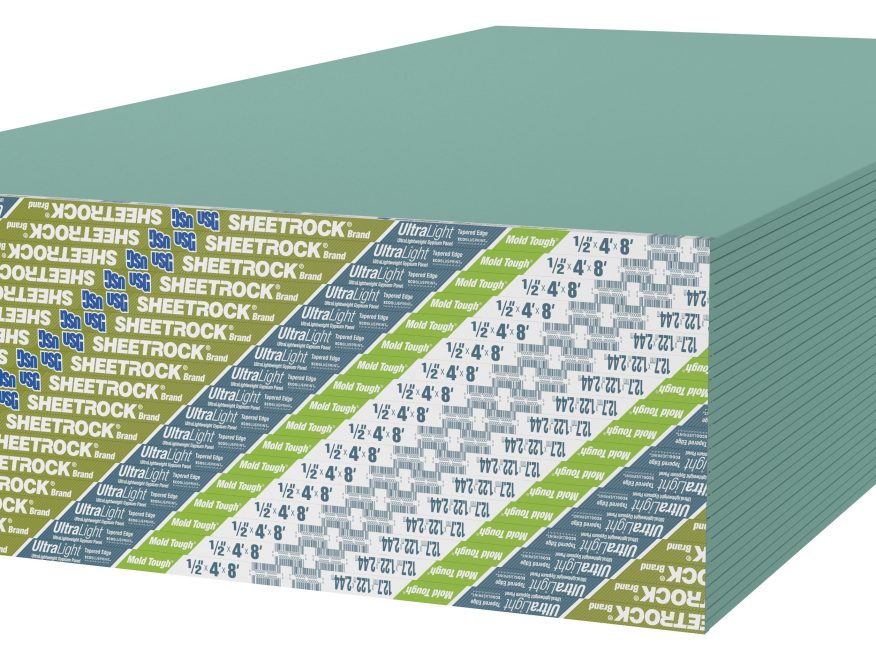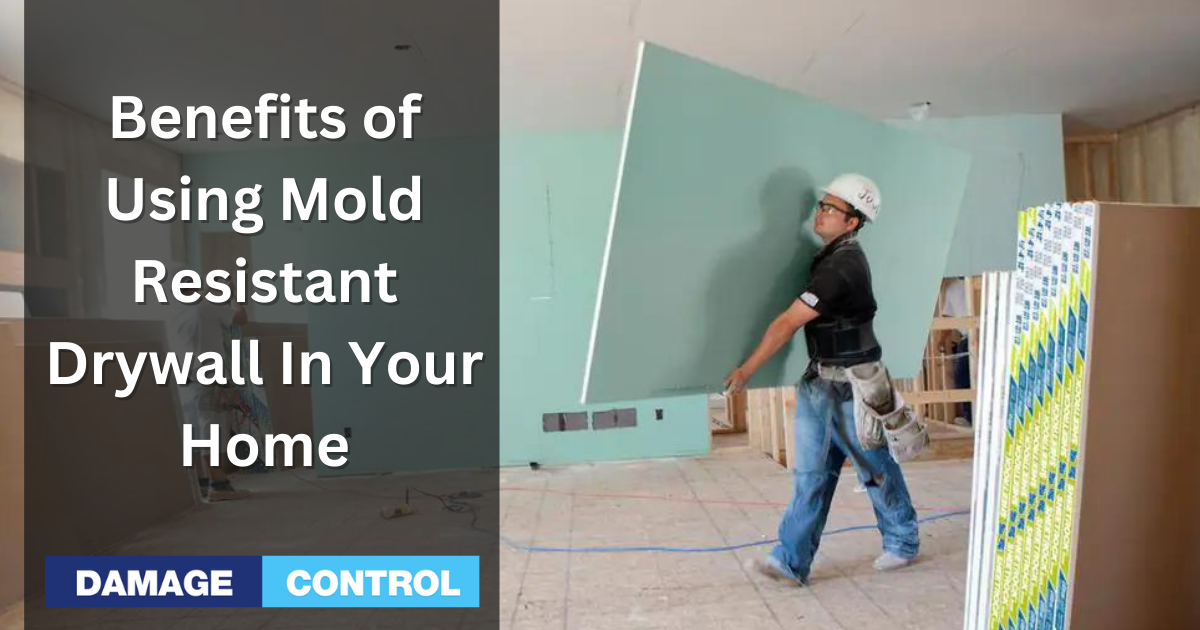Mold growth in the home can be a serious problem, and it is important to take steps to prevent it, especially during the initial construction. One of those steps is installing mold resistant drywall in rooms that are prone to being humid.
It has special additives that make it more difficult for mold spores to grow on or penetrate through. But installing this type of drywall requires some specialized knowledge and an understanding of common problems associated with its use.
In this blog post, we'll explore what exactly it is, how you install it correctly, potential issues you may encounter while using it, and the cost considerations when deciding whether to invest in this product.
What is Mold Resistant Drywall?
Definition of Mold Resistant Drywall
Mold-resistant drywall has a gypsum core and an inorganic, fiberglass facing on it instead of regular drywall, which has paper on the outside. You should note that mold-resistant drywall and “green board” are two different things. Green board has a waxy paper facing on it that only makes it water resistant, not mold resistant.
In the past, manufacturers used to provide both mold-resistant and water-resistant drywall products; today, they have mostly been combined into a single product. You should remember when deciding on the type of drywall to install that no drywall is immune to mold; it is only resistant.
 Benefits of Using Mold Resistant Drywall
Benefits of Using Mold Resistant Drywall
The primary benefit of using mold-resistant drywall is the prevention of costly repairs that can be the result of a mold infestation. Properly installed, it lowers the odds significantly that you will ever have an extensive mold problem in that space.
There are several different types of mold-resistant drywall available, depending on the level of protection needed from moisture-related issues such as humidity levels in a room or potential flooding events. These include standard gypsum board, paperless gypsum board (which uses fiberglass instead), and cement board (which offers additional strength).
Each one offers varying degrees of protection against water damage and should be chosen based on the specific needs of each area being renovated/constructed to achieve the desired results.
How to Install Mold Resistant Drywall
Preparation for Installation
Before you begin installing mold-resistant drywall, it’s important to ensure all surfaces are clean and debris-free. This includes removing any existing wall coverings or other materials that may be present on the surface.
Additionally, you should check for any signs of water damage or black mold growth to address these issues before installing new drywall. You can't simply install new drywall over insulation or framing that is contaminated with mold. Not only will the mold eventually spread elsewhere in the room, but if you're doing this for hire for someone else, you could be sued if this was discovered.
Step-by-Step Installation Process
Once all surfaces have been prepared, you can begin the process of installing new drywall panels.
Start by measuring and cutting each panel so it fits snugly against adjacent panels and within doorways or windows if necessary.
Secure each panel with screws spaced 12 inches apart along studs or joists in order to provide adequate support for the weight of the material.
Next, apply joint compound over seams between panels using a putty knife and allow this compound time to set before sanding down any excess material left behind after drying has occurred.
When taping mold resistant drywall, you should be using only fiberglass tape.
Finally, finish off your project by painting over newly installed walls with an appropriate paint type designed specifically for use on drywall surfaces such as latex-based paints which offer superior protection against moisture infiltration compared to oil-based alternatives. You can also use mold resistant primer before placing your intended topcoat color over it.
Common Problems with Mold Resistant Drywall
The biggest con for mold-resistant drywall is the cost. It's substantially higher in price compared to normal drywall. A single sheet of 1/2 inch 4x8ft mold resistant drywall is currently around $18 (as of January 2023). A sheet the same size of regular drywall is approximately $13.
Because of this cost difference, it's generally only used in areas with high moisture such as bathrooms, laundry rooms, near dishwashers, and water heaters. Any room where water runs would benefit from having this special drywall.
Causes of Damage to Mold Resistant Drywall
The most common cause of damage to mold-resistant drywall is moisture exposure. Moisture can enter the wall through cracks in it or plumbing leaks behind it. Other causes include improper installation, such as not using enough screws when installing panels or leaving gaps between them which can allow moisture in.
Several signs indicate there may be an issue with your mold-resistant drywall, including discoloration on the surface, bubbling paint or wallpaper, cracking along seams or edges, warping due to excessive moisture levels inside the wall cavity, sagging ceilings caused by water accumulation above them and musty odors coming from within walls.
If you suspect any water damage has occurred with your mold-resistant drywall, you must address it immediately before further deterioration occurs.
Depending on the severity of the problem, you may need professional help to properly repair or replace affected areas safely and effectively without causing additional harm, such as spreading spores into other parts of your home.
In some cases, minor repairs like patching holes can be done yourself, but a qualified contractor specializing in this type of work should always handle more serious issues. This will ensure everything is done correctly according to local building codes and regulations while protecting your family’s health during work.
Maintenance and Care for Mold Resistant Drywall
Regular Cleaning and Inspection Procedures
Regular cleaning and inspection of mold-resistant drywall is important to ensure that it remains in good condition.
It should be inspected at least once a year for signs of damage, such as cracking or discoloration.
Any areas that show signs of damage should be repaired immediately to prevent further deterioration. Additionally, the walls should be regularly wiped with a damp cloth to remove any dust or dirt buildup, and then the room should be dried via an exhaust fan or by opening windows for ventilation.
Preventative Measures to Avoid Damage to the Drywall
Preventive measures can help reduce the risk of damage to your mold-resistant drywall over time. For example, using mild detergents when cleaning instead of harsh chemicals can help protect the wall from becoming damaged by abrasive materials.
Also, avoiding contact with sharp objects near the wall can help reduce potential damage due to accidental scratches or punctures.
If you find that your mold-resistant drywall has become damaged beyond repair, several options are available for replacing it with new material. Depending on the extent of the damage, partial replacement or complete removal and installation of new boards may be necessary.
To ensure that all repairs are done correctly and safely so as not to cause additional problems down the line, it is best to hire an experienced contractor specializing in water damage restoration and mold remediation.
Cost Considerations for Installing and Maintaining Mold Resistant Drywall
Cost Factors Involved in Installing Mold Resistant Drywall
The cost of materials for installing new walls can vary greatly depending on the type of wall chosen. Generally speaking, higher quality materials will be more expensive and provide better protection against water damage and mold growth.
Additionally, labor costs associated with the installation may also need to be factored in.
Average Costs Associated with Replacing or Repairing Damaged Walls
Depending on the extent of the damage, replacing or repairing damaged walls can range from relatively inexpensive to very costly.
If only a small area is affected by water damage or mold growth, then repair costs may not be too high; however, if large areas have been impacted, then replacement may become necessary, which could result in much higher costs due to both material and labor expenses.
While investing in higher quality materials upfront may seem like an added expense at first glance, it could save money over time due to increased durability and resistance against water damage and mold growth compared to lower quality options.
This means that less frequent repairs or replacements would likely be needed resulting in overall savings down the line.
Conclusion
Mold resistant drywall is important to any water damage restoration and mold remediation project. It provides a layer of protection against future mold growth while providing a safe environment for your family. Installing it correctly and properly maintaining it are key to ensuring its effectiveness.
While the cost may be higher than regular drywall, the peace of mind that comes with knowing you have taken steps to protect your home from further water damage or black mold growth makes it well worth the investment.
Are you dealing with mold damage in your home or business? Damage Control 911 offers professional water and mold remediation services to help restore the affected areas.
We are certified experts at removing any existing contamination and preventing future problems through our use of advanced technology and materials such as mold-resistant drywall. Let us provide you with a safe, reliable solution to protect your property from further harm! Contact us today for more information on how we can help!

